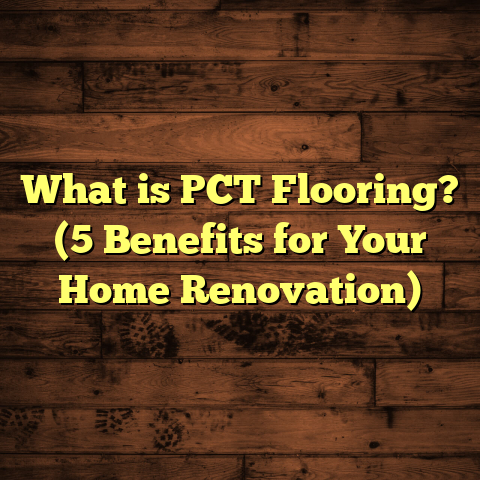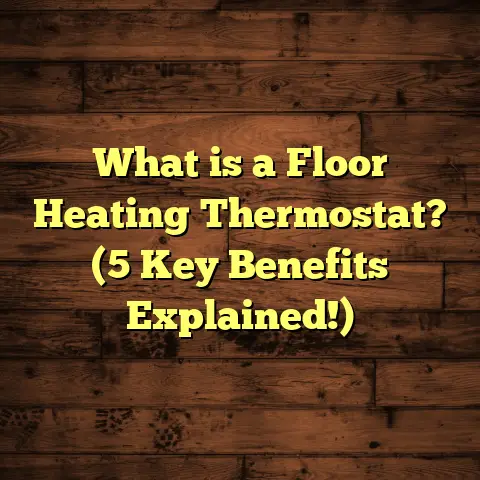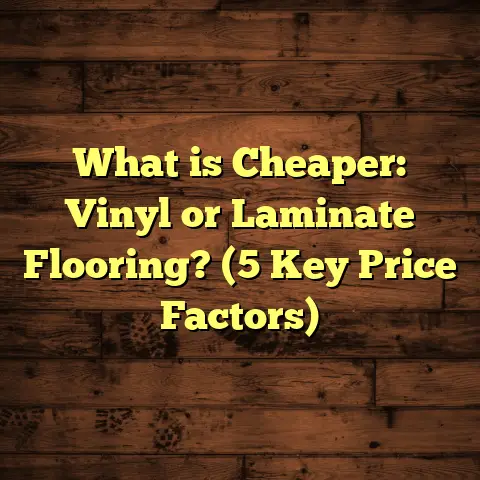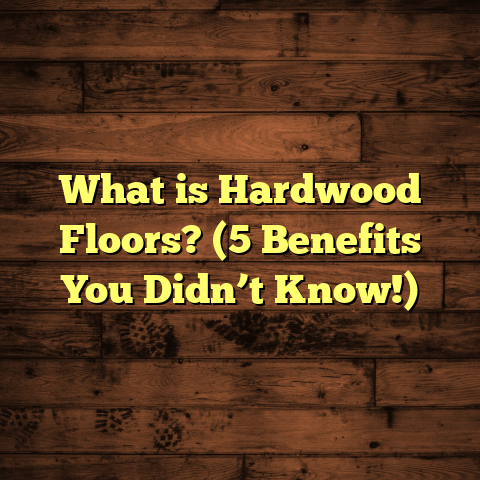What is LVL Flooring? (5 Key Benefits You Should Know!)
Did you know that LVL flooring can outperform traditional materials in both strength and versatility? I remember the first time I came across LVL—or Laminated Veneer Lumber—in a project. It was a game-changer for me, and I can’t wait to share the benefits with you.
Finding the Right Balance Between Form and Function
When I started working with LVL, I was amazed by how it combined the best of both worlds: strength and aesthetics. Imagine walking into a room where the flooring not only looks stunning but can also handle heavy foot traffic without breaking a sweat. That’s exactly what LVL can offer.
Key Benefits You Should Know!
1. Incredible Strength and Stability
One of my favorite things about LVL is its strength-to-weight ratio. Did you know it can support up to 1,000 pounds per square foot? This makes it an excellent choice for areas that receive a lot of wear and tear, like living rooms or hallways. Unlike traditional wood, which can warp or crack over time, LVL remains stable thanks to its layered construction.
I once worked on a commercial project where the client needed flooring that could withstand high foot traffic in a restaurant. We opted for LVL, and it held up beautifully over the years. The clients were thrilled, and so was I!
LVL is engineered from multiple layers of thin veneer glued together under heat and pressure. This process aligns the grain of the wood in the same direction, significantly enhancing its load-bearing capacity. In practical terms, this means you can use LVL in structural applications like beams and joists as well as in decorative flooring.
Statistics: According to a study by the American Wood Council, LVL can have a bending strength of over 2,000 psi (pounds per square inch), making it one of the strongest floor materials available today.
2. Environmentally Friendly
You’re probably aware of how important sustainability is nowadays. LVL is made from fast-growing trees, which means it’s a more environmentally friendly option than traditional hardwood flooring. In fact, using LVL can help reduce deforestation rates because it maximizes the use of each tree.
I had a client who was passionate about eco-friendly materials, and LVL fit perfectly into their vision for a sustainable home. They loved that they could have beautiful floors without compromising their environmental values.
Research Insight: A report from the Forest Products Laboratory highlights that LVL utilizes smaller logs that might otherwise go to waste, making it an efficient choice for sustainable building practices.
Additionally, many manufacturers source their timber from certified sustainable forests, ensuring that each plank aligns with eco-friendly practices. This means when you choose LVL, you’re not just getting quality flooring; you’re also supporting responsible forestry.
3. Versatility in Design
LVL flooring comes in various styles and finishes, making it easy to find something that suits your taste. Whether you’re aiming for a rustic look or something more modern, LVL can be customized to fit your design preferences.
I remember working on a home renovation where the homeowners wanted a contemporary feel. We chose a sleek, dark-stained LVL that completely transformed their space. It added depth and warmth, and the homeowners were ecstatic with the outcome.
Design Options: LVL is available in various thicknesses and widths, allowing for customization based on your specific needs. You can also choose different finishes—matte, glossy, or textured—to achieve the desired aesthetic.
Moreover, LVL can be stained or painted to match your existing decor seamlessly. This flexibility allows homeowners to maintain their unique style while benefiting from the durability that LVL provides.
4. Cost-Effective
Let’s talk money. LVL is often more affordable than traditional hardwood flooring while offering similar or even superior performance. With prices typically ranging from $3 to $7 per square foot, it’s a budget-friendly option for many homeowners.
On a recent project, I helped a family renovate their entire home on a modest budget. We used LVL throughout, which allowed them to stretch their dollars further without sacrificing quality.
Budget Breakdown: When considering costs, remember that LVL’s longevity means fewer replacements over time. Traditional hardwood might need refinishing every few years, while LVL’s engineered surface resists scratches and wear.
Here’s how to budget effectively for your flooring project:
- Material Costs: Factor in $3–$7 per square foot for LVL.
- Installation Costs: Depending on your location and contractor rates, installation can add another $2–$5 per square foot.
- Maintenance Costs: With proper care, you won’t need to replace or refinish your floors as often as with traditional wood.
By choosing LVL, you can allocate funds to other areas of your home renovation instead of worrying about frequent flooring replacements.
5. Easy Installation
Installing LVL flooring is generally quicker and easier than other types of flooring. Its lightweight nature means that you can handle it without needing heavy machinery, and many products come with tongue-and-groove edges for seamless installation.
During one installation, we completed an entire floor in just one day because of how user-friendly the material is. Homeowners often appreciate this efficiency because it minimizes disruption in their daily lives.
Installation Tips:
- Preparation: Ensure your subfloor is clean and level.
- Acclimation: Allow the LVL to acclimate to your home’s humidity levels for at least 48 hours.
- Tools Needed: A circular saw for cutting, measuring tape, a straight edge for marking cuts, and adhesive or nails depending on your installation method.
If you’re considering a DIY approach, make sure to follow all manufacturer guidelines for installation to maximize performance. YouTube has some great tutorials that can guide you through the process step by step!
What to Watch Out For
While I’m all for the benefits of LVL flooring, there are a few things to keep in mind. For instance, it’s not entirely water-resistant, so if you’re considering installing it in areas prone to moisture—like bathrooms or basements—you’ll need to take extra precautions.
I had a client who wanted to install LVL in their basement without proper moisture barriers. I advised them against it, and they decided to go with tiles instead, which worked out better for their situation.
Moisture Management Tips:
- Sealants: Use moisture barriers beneath the LVL if installing in areas prone to dampness.
- Ventilation: Ensure adequate airflow in spaces like basements to minimize humidity levels.
- Regular Inspection: Check for signs of moisture damage periodically, especially if installed near water sources.
Personal Anecdotes: Real-Life Applications
To illustrate the benefits further, let me share some real-life experiences from my projects:
Case Study 1: The Busy Restaurant
I worked on a bustling restaurant that needed flooring capable of enduring daily spills and heavy foot traffic. We chose LVL due to its strength and ease of cleaning. After installation, the owners noticed how well it held up compared to the previous hardwood floors they had.
Case Study 2: The Eco-Conscious Home
Another project involved a family dedicated to sustainability. They wanted materials that reflected their values without compromising style. Using LVL allowed them to achieve an elegant look while knowing they were making an environmentally responsible choice.
Case Study 3: The Budget Renovation
A couple approached me about renovating their outdated home on a tight budget. By selecting LVL flooring throughout their living spaces instead of more expensive options like solid hardwood or high-end tile, they were able to allocate funds toward updating their kitchen instead—a win-win situation!
Maintenance Tips for Longevity
One of the most significant advantages of LVL is its low maintenance requirements. Here are some tips I’ve learned over the years:
- Regular Cleaning: Sweep or vacuum regularly to remove dirt and debris that can scratch the surface.
- Damp Mopping: Use a damp mop with a mild detergent for deeper cleaning; avoid excessive water as it can seep into seams.
- Protective Pads: Place felt pads under furniture legs to prevent scratches and dents.
- Avoid Harsh Chemicals: Steer clear of abrasive cleaners or those containing ammonia as they can damage the finish.
Future Trends in Flooring
As I see it, LVL is just the beginning when it comes to innovative flooring materials. The industry is continuously evolving with new technologies aimed at improving performance while being environmentally conscious.
Emerging Technologies:
- Smart Flooring: Imagine floors equipped with sensors that monitor moisture levels or warn about temperature changes—this could revolutionize how we maintain our homes.
- Sustainable Innovations: Companies are researching new methods to produce even more eco-friendly materials from recycled wood fibers or other sustainable resources.
Conclusion
LVL flooring has truly revolutionized the way we think about flooring options. Its combination of strength, versatility, cost-effectiveness, and eco-friendliness makes it an excellent choice for many different applications.
If you’re considering new flooring, I highly recommend looking into LVL. You’ll find that it not only meets but often exceeds expectations in both performance and style.
Have you thought about using LVL for your next project? I’d love to hear your thoughts!





